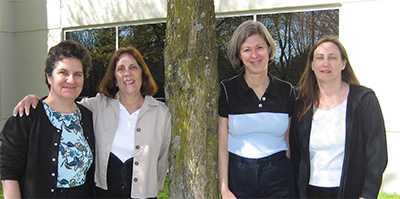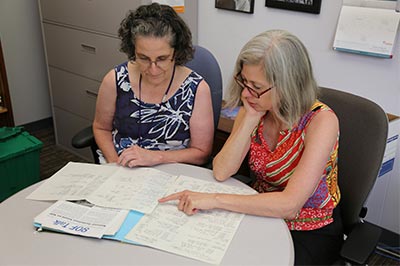Landmark Study of Osteoporotic Fractures Draws to a Close After 31 Years
Stories - Sep 20 2017

Our longest-running CHR study has produced dramatic discoveries, hundreds of scientific papers, and memorable relationships between researchers and participants.
Launched in 1986, the Study of Osteoporotic Fractures (SOF) set out to identify risk factors that predict fractures in community-dwelling women 65 years and over. At that time, osteoporosis was recognized only after a fracture occurred. With the unfailing dedication of more than 10,000 participants and a core of about 20 investigators, along with many others who used SOF for their training, SOF has become a national scientific treasure and resource—not just in predicting fracture risk and helping to prevent fractures, but also in many other domains of healthy aging.
In the beginning, a sentinel risk factor that SOF investigators sought to determine was bone mineral density (BMD) and how it might identify women at high fracture risk. The SOF team evaluated the emerging BMD technology that would quickly develop into the dual energy X-ray absorptiometry scan, or DEXA.
The SOF team proved that DEXA could accurately, safely, and painlessly predict which postmenopausal women were at risk for osteoporosis and fractures. This finding revolutionized both the field of osteoporosis research and clinical care for preventing and treating fractures.
 SOF team members Jan Van Marter, Jane Wallace, Teresa Hillier, and Ann Macfarlane (left to right) gather for a photo in 2006. Jane Wallace passed away in 2015.
SOF team members Jan Van Marter, Jane Wallace, Teresa Hillier, and Ann Macfarlane (left to right) gather for a photo in 2006. Jane Wallace passed away in 2015.In 1995, SOF researchers published a seminal paper that answered the original study question and established the evidence to use DEXA as a screening test for osteoporosis. DEXA quickly became the gold standard in clinical care, not only for osteoporosis screening but also for monitoring treatment.
Over time, SOF researchers used the rich data they gathered to explore a wide range of issues—such as healthy aging, cognitive and physical function, breast cancer, sleep, heart disease, and vision problems—and published more than 400 scientific papers. Of the 10,000 women from across the country who contributed to this extraordinary scientific and clinical achievement, a quarter of them were Kaiser Permanente members in Oregon and Washington.
Today, after 31 years, SOF is drawing to a close as its funding ends this year. The SOF research teams are now publishing their final papers and archiving years of study documents that include floppy-disk files, hand-written budgets, and other artifacts that illustrate the remarkable longevity of this landmark study. And in the process, SOF researchers and staff are reflecting on what the study has meant for older women and for the Center for Health Research.
Identifying Risk: the Key to Prevention
“Until we had a diagnostic tool to predict fractures, we just had to wait until women had a fracture to start treating them. Prevention was impossible,” says Teresa Hillier, MD, who leads the SOF study for CHR and has worked on the project for 17 years. “Once we established the DEXA scan as a good diagnostic tool, we could start preventing osteoporosis and fractures from happening in the first place.”
That’s important because, as the SOF study also showed in a publication led by Erin LeBlanc, MD, women who fall and break their hip have a much higher risk of dying compared to women who don’t—a risk as much as five times higher within the first year after the fracture.
Another important SOF finding is that women who lose more than two inches in height have an increased risk for fracture and early death.
 Teresa Hillier (right) and Jan Van Marter pore over archival materials as they prepare to bring the SOF study to a close.
Teresa Hillier (right) and Jan Van Marter pore over archival materials as they prepare to bring the SOF study to a close.Jan Van Marter, SOF project manager for the last 16 years, notes that these findings wouldn’t have been possible without the exceptional cooperation of SOF’s participants.
“These women were incredibly dedicated to this study,” Van Marter says. “We asked them to answer questions about their health every four months and come in for medical visits every three to five years for the entire length of the study. Even after 31 years, 96 percent of our active participants completed the final questionnaire last fall.”
Investing in Relationships
More than a hundred Center for Health Research staffers have worked on the SOF study, which also offered valuable opportunities to mentor emerging investigators. The larger SOF study mentored Dr. Hillier, who was the third CHR site PI; in turn, Dr. Hillier mentored investigators Erin LeBlanc, MD, and Kim Vesco, MD, as well as Kathy Pedula, MS, to lead SOF publications.
This tradition of encouragement and care also extended to participants. Van Marter describes SOF, with its high levels of engagement and retention, as “a poster child for what can happen when staff invest time and effort to create rapport and strong relationships with participants”.
Ann Macfarlane, SOF Outcomes Coordinator at CHR, describes the SOF generation of women as “truly remarkable.”
“They understood the meaning of commitment,” Macfarlane explains. “Their motivation for participating over such a long period wasn’t about what they could get out of the study, but rather what they could give. I don’t know how many times I heard, ‘If it can help someone, I’m happy to do it.’ These dedicated ladies cared and wanted to make a difference. We assured them they contributed more than they could imagine. It has been inspiring for me to hear their stories, and I feel fortunate to have had a connection with them.”
Women had to be at least 65 when the study started recruiting in the mid-1980s. Some of the oldest participants were born in the late 1800s, but most were born in the early 1900s.
Macfarlane has also led SOF retention efforts for the last decade, and the SOF participants loved their SOF calendars, refrigerator magnets, note pads, and other items they received annually. Each Christmas, study staff would send updates about study findings, informing participants about how their commitment to the study was advancing science. They also received birthday cards every year.
A good number of participants have now lived well past their 100th birthday. “When a SOF participant turned 100 several years ago,” Dr. Hillier recalls, “Ann asked me if I would include a hand-written note congratulating her on becoming 100 years old. Little did I realize this would become a frequent occurrence, as we’ve had many new centenarians over the last several years.”
Last spring, when Macfarlane called to tell participants the study was ending, one woman had this to say: “Truth be told, we should be thanking you. Every time I hear or read something exciting about the study, the feeling of proud goes through me. Besides, I have a wonderful picture of my skeleton and another beauty of my right hip.”
Remembering Ann Taggard
Ann Taggard, a SOF participant, was featured in a video about the study in 2011. She has since passed away.